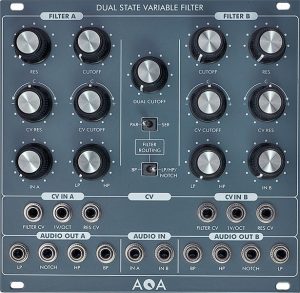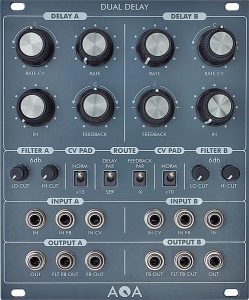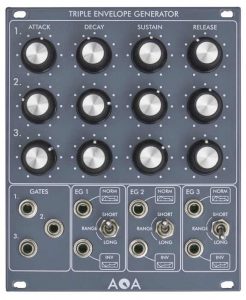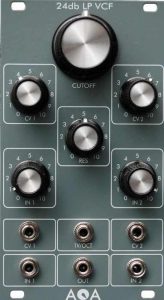OK so here we have a really interesting new entry into Eurorack. AQA ElektriX obviously come at this from a slightly different angle from most and it’s an angle we like very much. Think of a pro sound engineering approach to Euro and you’d be on the right track. Most of their modules are designed with stereo in mind, which appeals to me greatly.
AQA’s slightly strange strap line is “Made and loved in Berlin” and once you experience their gear first hand you’ll understand what they mean. The first impression is the packaging (call me shallow if you like), the modules are wrapped in tissue paper (with boxes of course). The next thing you’ll notice is the beautiful battleship grey/blue of the modules, but also the build quality which is second to none and a world apart from some Eurorack modules of mass manufacture and wobbly knobs.
Once you start to look at the inputs, outputs and controls, you really  start to realise the thought that’s gone into these modules. As a pro sound engineer myself, I get the feeling that the designer of these “knows their stuff”.
start to realise the thought that’s gone into these modules. As a pro sound engineer myself, I get the feeling that the designer of these “knows their stuff”.
For instance, the new Dual delay. No dry signal is passed to the output. “What!!??” I said initially, before realising that the way that I use delays / reverbs in a mixing type set up is with axes and ‘wet only’ returns. The dual delay has all sorts of serial / parallel routing possibilities for both audio and cv, with normalising if only inputting one or mono inputs. High and low pass filters are available on both channels, along with possibilities for inputting and outputting external feedback loops. All with comprehensive CV control. I consider this to be probably the most interesting BBD delay out there at the moment, as I really love stereo, and well made euro modules.
Next up, M/S Matrix. Even more interesting perhaps. Firstly what the heck is Mid-side? I sometimes have to use it in TV mixing, when sound recordists deliver sound in M/S from location. On location while recording dialogue, recordists use a hyper cardioid mono mic to “zoom” into the actor. Often they will now add a “figure of 8” mic which will record left / right room or external ambience. When combined with some phase reversal in post-production (or M/S decoding), you can uncover some rather nice stereo. You can alter the width of the stereo by the amount of ‘side’ signal you add the the centre mono signal. With this module you deconstruct a stereo signal and output sum and difference, or combine two mono signals, combine with CV modulation to create some perhaps never before heard of sounds.
Next up is possibly the pinnacle of their module selection, the Dual “State variable filter”. Again, this module has a nod to stereo which I really appreciate. Two independant fully featured filters but with stereo linking capabilities and a common cutoff pot.
The Dual 12 dB State Variable VCF module contains two 12dB state variable multimode VCF´s A and B, which both offer a Lowpass, a Bandpass and a Highpass filtered output of the input signal as well as a Notch-output, simultaneously.
Rounding off AQA’s current modules is the Quadrature LFO
The Quadrature LFO is generating an sine wave and 3 phase-shifted copies of it:
by 90° (cosine), 180° (inverted sine) and 270° (inverted cosine).
The frequency of the LFO can be voltage controlled, the CV input is attenuverted.
All in all, AQA is a really interesting new manufacturer to have entered the Eurorack scene with an individualistic approach to high end audio needs. We are proud to be representing them and look forward to future offerings.









